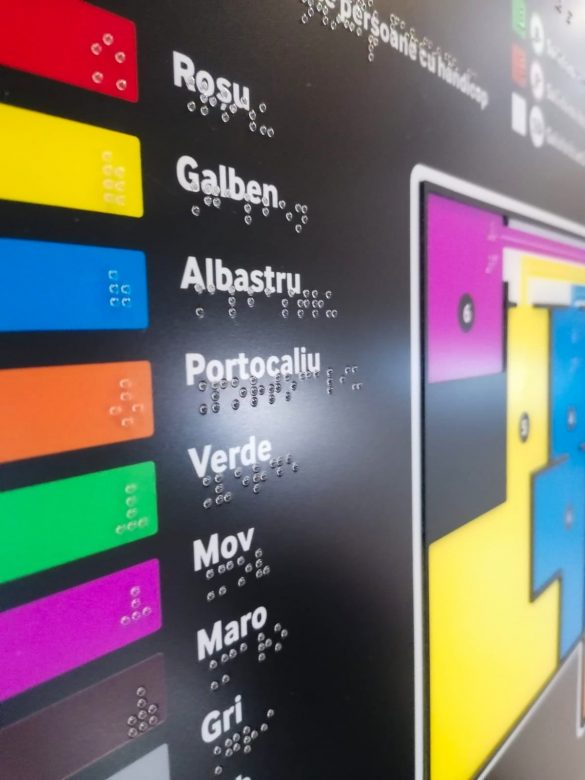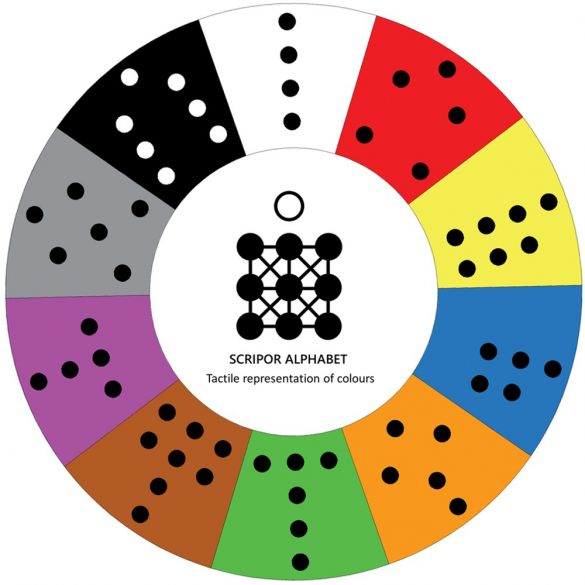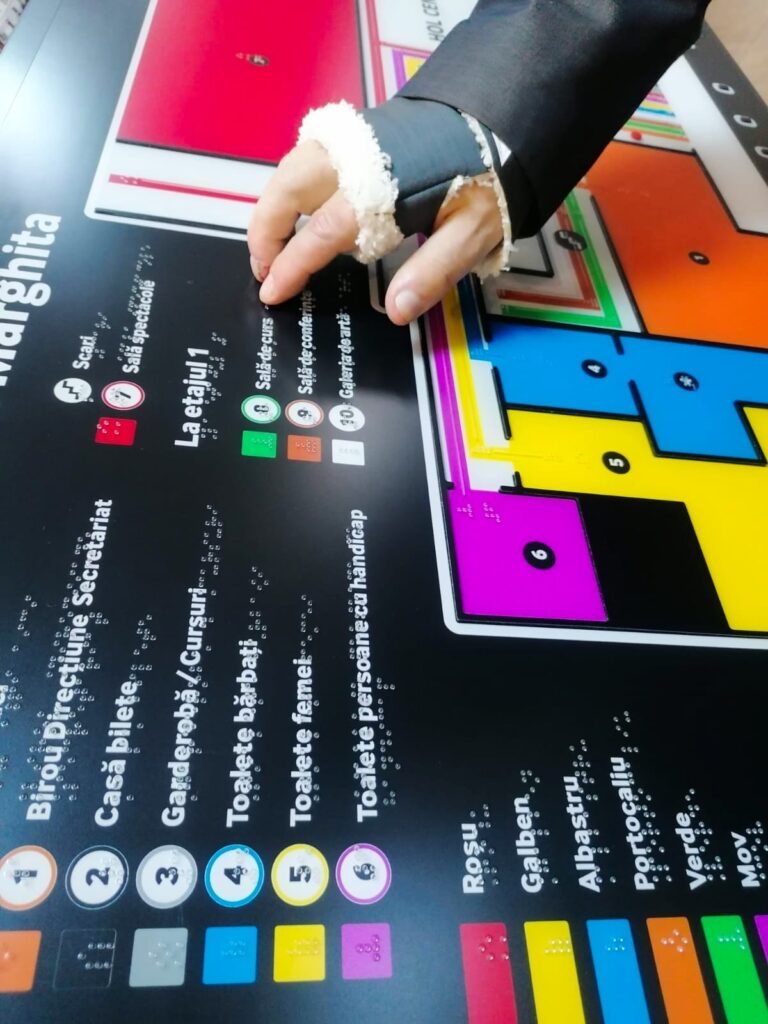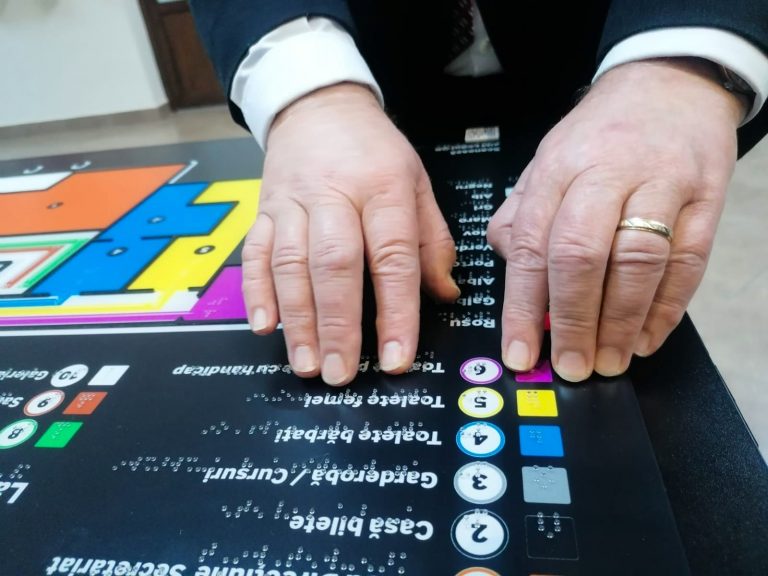After more than seven years, numerous failures, tests, and attempts, the tactile Alphabet of Colors, which has been worked on for approximately two years for the patenting part, Tudor Paul Scripor has invented a method for tactile-graphic representation of colors using a symbol. The Scripor Alphabet essentially transforms a disability into a super ability, providing hope, freedom, independence, and the creative expression for visually impaired, partially sighted, or color-blind individuals. His educational project was awarded the gold medal at the 2019 International Exhibition of Inventions and Innovations in Geneva, receiving the Grand Prize from the German Inventors Association.
In terms of professional integration, visually impaired and color-blind individuals have a significant advantage thanks to the Scripor Alphabet. They can engage in activities involving color sorting or selection. By implementing this tactile alphabet worldwide, an old barrier is falling, one that affects individuals with various visual impairments, namely the inability to work in different fields such as food service, sports, education, or technology.
According to statistics provided by the European Blind Union, there are over 100,000 blind people in our country and approximately 30 million in Europe.
From what started the idea of creating a tactile Alphabet of Colors – (the Scripor Alphabet)
“In 2012, I organized a workshop which was attended by a blind student. I was teaching painting and restoration techniques, and at the end of the workshop, the visually impaired person gave me a negative feedback. He reproached me for not being able to help him understand colors. Later, I searched on Google for a suitable language for colors for the blind and realized that it didn’t exist. Discouraged from those around me, but with the support of my wife and a good friend, I decided to develop a standardized language for visually impaired individuals.”
“After 7 years, numerous failures, tests, and attempts, the tactile alphabet of colors, which took an additional 2 years for the patenting process, emerged. In April 2019, together with my team, we decided to publicly launch it because an alphabet should be public and free. We thought the best opportunity would be the Inventions and Innovations Salon in Geneva, as it is the most renowned event. There, we had a pleasant surprise. The tactile alphabet of colors won the gold medal in the art, culture, and education category, as well as the grand prize offered by the German Inventors Association,” shares Tudor Scripor, the inventor of the Tactile Alphabet of Colors for the Visually Impaired.
The need for a standardized alphabet of colors was being discussed at the European level, but the fact that Tudor adapted it for the visually impaired was a significant achievement. “This alphabet is an extension of the Braille alphabet. It is used by the visually impaired for writing and reading. It can be used to write numbers, letters, punctuation marks, diacritics, and even musical symbols. However, there was no common language for colors. For example, to write the word ‘blue,’ one would have to write all the characters that make up the word. With the help of the tactile alphabet, the entire word is reduced to a single symbol, making it a universal alphabet,” explains Tudor Scripor, a specialist in art, restoration, and icon painting.
How was the Scripor Alphabet actually created, the one that can be learned in a matter of hours
The alphabet is composed of the colors yellow, red, blue, orange, green, brown, violet, white, black, and gray, but it can also represent lighter shades of colors. You may wonder how this is possible. “For example, pink is a lighter shade of red. Next to the red color cell, there is also a white color cell, and through two touches, a visually impaired person knows that it is pink,” says Tudor.
An embossing printer pushes the paper and creates reliefs of the alphabet: “For instance, on packs of medicine, there are some dots. Those dots are part of the Braille alphabet. The alphabet of colors has dots of the same size and distance as Braille. The main difference between them is the orientation point. When visually impaired individuals realize there is that specific point, they know they have the color alphabet in front of them.”
The feedback received from the visually impaired is quite positive.
“The Braille alphabet is learned over the course of a year or even two, unlike the alphabet of colors, which can be learned in just a few hours,” confesses its inventor.
The Scripor Alphabet does not convey visual or chromatic information, but it still makes several functions of colors accessible. “Color, if you cannot see it, does not trigger emotional experiences and does not create a sense of beauty. It’s similar to music. If you cannot hear it, you do not experience it. It is futile to have musical notation in visual or tactile format because simply touching or reading musical notes does not evoke feelings. It is important to make this clarification so that no one understands that the tactile alphabet will make the visually impaired ‘see’ colors. Nevertheless, the invention plays an extremely important role in the lives of the visually impaired,” explains the technological consultant of the “Scripor Alphabet” Association, Ștefan Toth, who has had visual impairment since childhood.

The opportunities for the visually impaired achieved with the help of the Alphabet of Colors
“We have made the game of Rummy accessible for the visually impaired. Previously, they couldn’t play the game openly because color-related information was missing. On the Rummy tile, we have embossed the number. For example, the number 1, for those who do not know the Braille alphabet, can determine the number through touch. Later, we added the element of color and played Rummy with the visually impaired, and the barriers were overcome.”
The tactile alphabet of colors is not dependent on learning the Braille alphabet: “However, those who are familiar with it learn the tactile alphabet of colors much faster. Essentially, the Braille cell consists of 6 dots in two columns. I added another column, and above it is an orientation point or what the visually impaired refer to as a ‘landmark,’ which determines the position of the cell. If we use it on clothes, this color labeling, based on the reference point, allows the visually impaired to know the position of the cell.”
Another example is in Paralympic sports, where karate belts have been made accessible: “There are visually impaired athletes who engage in contact sports such as martial arts. Previously, the sensei had to remember the color of each athlete’s belt before competitions. We have overcome this barrier and provided independence to the athletes, with each one choosing the belt that corresponds to their rank. On the right end, there is the color symbol, and everyone knows it. Additionally, we have overcome the barriers of flag colors, diplomas, and medals.”
Through the Scripor alphabet, the playful potential of colors, meaning games or entertainment, is opened up for the visually impaired. A person with visual impairment can decorate a Christmas tree on their own if all the decorative elements are labeled with tactile symbols for color: “On a tactile board, we can place the colored ornaments in any position we want. The visually impaired person may struggle with this, and if the audio descriptive information is not sufficient, we want to print tactile images showing the position of the ornaments to provide them with additional information.”
The NGO develops various products, games, or toys: “An example is the Rubik’s Cube. Last year, in July, after we posted about creating the Rubik’s Cube, we already had orders from all over the world, including countries like Brazil, Germany, or the USA,” emphasizes Tudor Scripor.
At the same time, the Scripor Alphabet represents a major innovation in education: “Tactile maps in geography can also include the element of color. By having access to the alphabet of colors at school, which is also necessary for learning these tactile symbols, the student learns from an early age the functions and meanings of colors. They will know that water is marked in blue on the map, plains in green, and mountains in brown. In addition, they can learn about the depth and altitude of mountains if they learn the chromatic standardization, meaning the significance of colors in geography,” adds Stefan Toth.
The New Horizons application
At this moment, the application is in the project phase as intensive work is being done on the second part: “It is called New Horizons and will also provide clothing suggestions. If it’s an orange shirt, the application will suggest how to match the rest of the clothing items. The label at the back of the neck is tactile, as well as the ones on the sides.
There are many areas where this alphabet is highly compatible with technology. Our goal is for our application to be free and without the need for an internet connection. Literacy refers to providing access to as many unconditioned individuals as possible, meaning all visually impaired people worldwide.”
The color of clothes is a whole area to explore: “One of the biggest challenges for people with visual impairments is making their wardrobe accessible. Unfortunately, they cannot go and purchase clothes on their own. Based on artificial intelligence, we have created a smartphone application that recognizes the position of the dots and vocally describes the color. Even in darkness or low light conditions, color detection apps provide inaccurate information. On the other hand, the New Horizons application activates the flash, recognizes the dot combinations corresponding to colors, and provides accurate information,” explains the inventor of the alphabet.

Online Educational Platform with the Option to Download the Alphabet / Schools Will Receive Donations
The alphabet of colors is the language included in the ABC, the basic book. Tudor emphasizes that an alphabet “cannot have a cost,” but the book does, as the Association cannot sustain itself financially yet.
“We participated in Geneva with the ABC, the basic manual. Currently, it is being edited and translated into many languages. When it’s ready, it will have a price and will be available worldwide on many platforms. For Romania, we have thought of a different strategy. For example, if a school or institution wants the manual or a Rubik’s Cube, a sponsor will buy them and donate them to the school. Selling is not our interest. We don’t want to sell books or games to customers. As an NGO, we sustain ourselves. We rely heavily on donations.”
However, if someone wishes to buy it, they will have that possibility.
“We are working on an educational platform that will facilitate learning this alphabet in all languages. During the pandemic, in February, we signed a collaboration agreement with the Ministry of Education. Through that protocol, Romania was the first country to implement this type of alphabet in special schools. Just a month later, the pandemic hit, and we couldn’t continue the project.
We realized that we entered the era of digitalization, and due to the hundreds of requests coming from the internet, we created an online platform, completely free, with audio-video instructions. Moreover, it will also have a download section. If a visually impaired person has a compatible printer, they can download the alphabet of colors for free from America or anywhere in the world. It’s easier to have it in a physical form since it’s tactile,” adds Tudor Scripor.
More Appreciated Abroad than in the Country
Representatives of the “Scripor Alphabet” Association have a slight regret after all the work they have put in: “Our project is very well received by organizations abroad but with disinterest in Romania. But that’s how we Romanians are. We need confirmation from abroad to realize the good things done here.”
Nomination for the World Idol 2021 Award/Organization of the Year 2021
Tudor Scripor has been nominated for the World Idol 2021 award, an international competition organized by the Chance for the Blind Foundation, an event held under the high patronage of the President of the Republic of Poland, His Excellency Andrzej Duda! His nomination came along with that of the “Scripor Alphabet Association” in the category “Organization of the Year 2021.”
Tudor is aware of his position in this competition, but if you want to show your support by voting, you can do so by accessing this link: https://idol.chancefortheblind.org/vote/1964.
“Any innovation comes with a certain reluctance, and it’s very natural. Even though people prefer not to step out of their comfort zone, an innovation manages to push them. This confirmation comes somewhat naturally in 2021. In April 2019, I was in Geneva, and in October, I was invited to a conference in Poland where I presented this alphabet in person. In 2020, due to the pandemic, I presented the applications and the progress of the project online. Basically, only now, in 2021, the seeds have started to sprout. The results are only starting to show. 2020 was a year of pause, it pulled us down a lot. The only good thing that happened was that we had this idea of transitioning from physical implementation in schools to online,” concluded Tudor Scripor.


